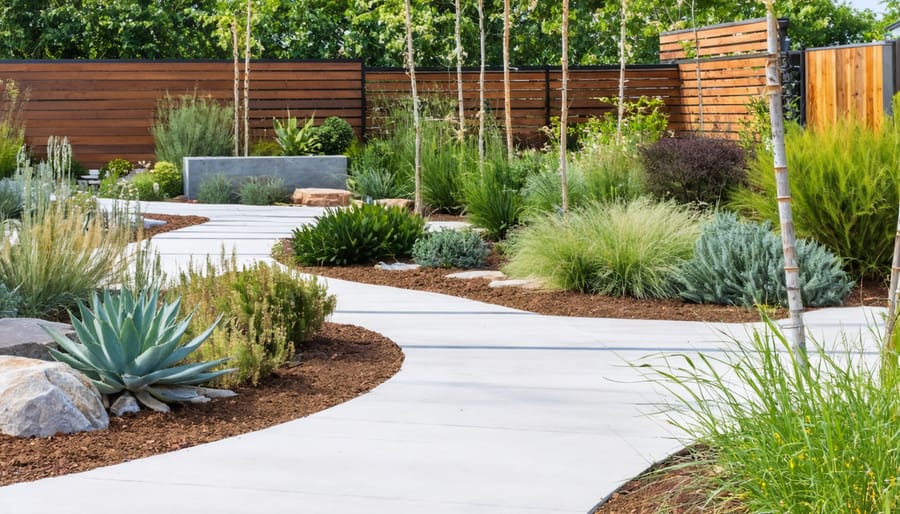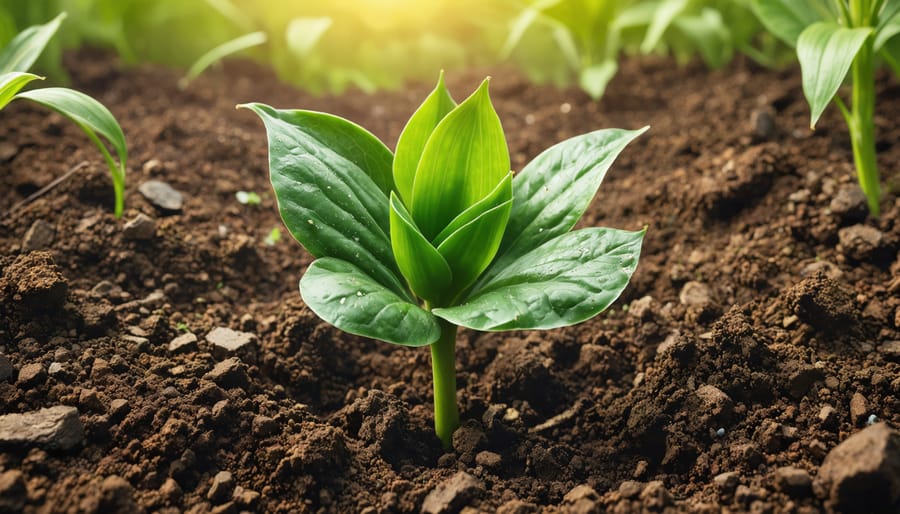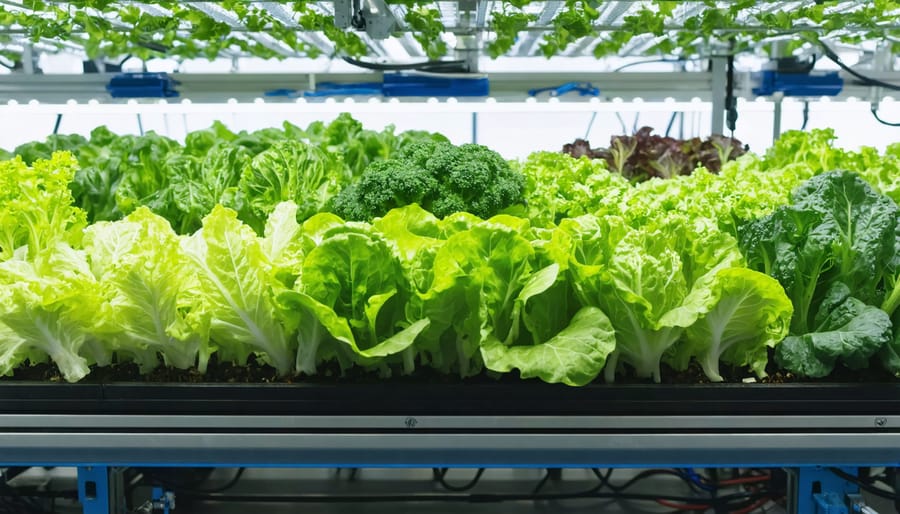Transform your landscape into a water-efficient oasis by grouping plants with similar water needs, a technique called hydrozoning that cuts water waste by up to 30%. Install smart irrigation controllers and water-saving solutions like drip systems to deliver moisture directly to root zones, reducing water usage by 50% compared to traditional sprinklers. Replace thirsty lawns with drought-resistant native plants and ornamental grasses that thrive in your local climate while creating stunning visual interest. Layer three inches of organic mulch around plants to retain soil moisture, prevent evaporation, and naturally suppress water-hungry weeds – a simple step that saves up to 10 gallons per square foot annually. Modern landscaping doesn’t require choosing between beauty and conservation; thoughtful design and smart technology work together to create vibrant, sustainable outdoor spaces that protect our precious water resources while delighting the senses.
Design Your Landscape for Maximum Water Efficiency
Zone Planning for Water Conservation
Zone planning, or hydrozoning, is one of the smartest strategies for water-wise landscaping. By grouping plants with similar water needs together, you’ll create efficient watering zones that prevent both over- and under-watering while maintaining a beautiful garden.
Start by dividing your landscape into three main hydrozones: high, moderate, and low water-use areas. High-water zones might include lush flowering plants and vegetables that need regular watering. Place these plants closer to your home where you can enjoy their beauty and monitor their water needs easily.
Moderate-water zones work well for established perennials and ornamental grasses that can thrive with less frequent watering. These plants are perfect for creating attractive transitions in your landscape while maintaining water efficiency.
Low-water zones are ideal for drought-tolerant native plants and succulents that rarely need supplemental water once established. Consider placing these in more distant parts of your yard or in naturally drier areas like slopes.
When planning your zones, take advantage of natural features in your landscape. South-facing areas and spots near reflective surfaces typically need more water due to increased evaporation, while shaded areas retain moisture longer. Group plants accordingly to maximize water efficiency.
Remember to install separate irrigation systems for each zone, allowing you to water different areas according to their specific needs. This targeted approach ensures every plant gets exactly what it needs – no more, no less.
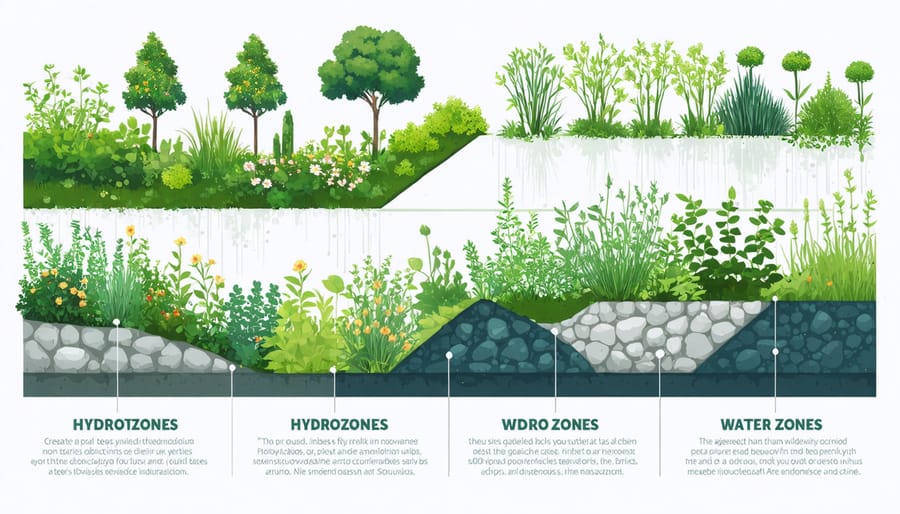
Strategic Hardscaping Solutions
Smart hardscaping choices can dramatically improve your landscape’s water efficiency while maintaining its beauty. One of the most effective strategies is incorporating permeable surfaces throughout your outdoor space. Unlike traditional concrete or asphalt, permeable materials like gravel, permeable pavers, or pervious concrete allow rainwater to seep naturally into the ground, reducing runoff and replenishing groundwater supplies.
Strategic grading is another crucial element in water-wise landscaping. By carefully contouring your yard, you can direct water flow to where it’s needed most. Create gentle slopes that guide rainwater toward plant beds and away from foundations. Consider installing swales – shallow channels that slow water movement and increase absorption – or rain gardens in low-lying areas to capture and utilize rainwater naturally.
For driveways and walkways, consider installing ribbon driveways (two parallel strips with vegetation between) or using spaced pavers with hardy groundcover growing between them. These solutions not only look attractive but also significantly reduce water runoff while providing functional pathways.
Don’t forget about retaining walls and terracing. These features can prevent erosion on slopes while creating level areas that retain moisture more effectively. When designing terraces, incorporate small berms or lips at the edges to help capture and hold water, giving plants more time to absorb it.
Remember to maintain proper drainage away from your home’s foundation while implementing these water-retention strategies. The goal is to slow water down, not create flooding issues.
Water-Wise Plant Selection Made Simple
Native Plants That Thrive on Less
Native plants are nature’s water-wise champions, having evolved to thrive in your local climate with minimal irrigation. These resilient plants have developed deep root systems and specialized features that help them survive on natural rainfall alone, making them perfect choices for a water-conscious landscape.
In the Western regions, consider drought-tolerant beauties like California poppies, salvias, and manzanitas. Their silver-gray foliage not only adds visual interest but also helps reflect sunlight and conserve moisture. Southwestern gardens flourish with desert-adapted plants such as agaves, yuccas, and colorful penstemons.
For Midwestern landscapes, prairie natives like purple coneflowers, black-eyed susans, and little bluestem grass create stunning displays while handling both drought and occasional flooding. Eastern gardens benefit from adaptable natives such as butterfly weed, blazing star, and Eastern red columbine, which provide year-round interest and support local wildlife.
The Pacific Northwest offers a wealth of shade-tolerant natives like sword ferns, Oregon grape, and flowering currants that thrive in the region’s unique conditions. In the Southeast, try native beauties such as butterfly milkweed, blanket flower, and muhly grass, which handle heat and humidity with grace.
When selecting native plants, consider grouping them according to their water needs, a practice known as hydrozoning. This approach not only conserves water but also creates natural-looking plant communities that support local ecosystems. Remember that even drought-tolerant plants need regular watering during their first growing season to establish strong root systems. Once established, these hardy natives will reward you with years of low-maintenance, water-wise beauty.
Beautiful Drought-Tolerant Alternatives
Creating a water-wise landscape doesn’t mean sacrificing beauty. Today’s drought-resistant plants offer stunning alternatives to traditional thirsty varieties, bringing color, texture, and life to your garden while consuming minimal water.
Lavender is a perfect example, offering fragrant purple blooms and silvery foliage that creates a Mediterranean atmosphere. Its hardy nature and low water requirements make it an excellent choice for sunny borders or decorative hedging. Russian Sage is another showstopper, with its airy purple spikes that dance in the breeze and attract butterflies throughout summer.
For groundcover, consider Ice Plant with its vibrant daisy-like flowers in pink, purple, or yellow. This succulent spreads beautifully and transforms into a carpet of color during blooming seasons. Sedum varieties, with their fascinating geometric patterns and changing seasonal colors, offer year-round interest without demanding frequent watering.
Native plants naturally excel in local conditions. Black-Eyed Susans bring cheerful yellow blooms that last for months, while Yarrow offers flat-topped flower clusters in various colors, from classic white to deep red. Both establish deep root systems that help them thrive with minimal irrigation.
For dramatic architectural elements, consider incorporating ornamental grasses like Blue Fescue or Mexican Feather Grass. These low-maintenance options add movement and texture to your landscape while requiring very little water to maintain their striking appearance.
Remember to group plants with similar water needs together, creating visually appealing combinations that are also practical for efficient irrigation. With thoughtful selection, your water-wise garden can become a stunning showcase of sustainable beauty.
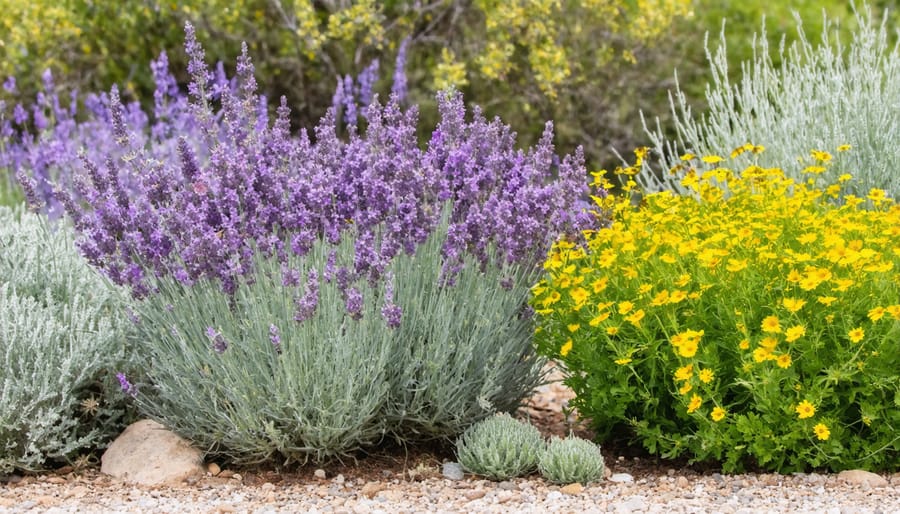
Smart Irrigation Technologies and Techniques
Drip Systems and Smart Controllers
Modern smart irrigation techniques have revolutionized the way we water our gardens, and drip systems are leading the charge in water conservation. These efficient systems deliver water directly to plant roots, eliminating the waste associated with traditional sprinklers and reducing water usage by up to 70%.
Setting up a drip system might seem daunting at first, but it’s actually quite straightforward. Start with a basic kit that includes a timer, filter, pressure regulator, and drip tubing. Place the tubing along your plant rows or around individual plants, and use emitters to control water flow. The beauty of drip irrigation is its flexibility – you can easily modify the system as your garden grows or changes.
Smart controllers take water efficiency to the next level by automatically adjusting watering schedules based on weather conditions. These clever devices connect to your local weather station or use built-in sensors to measure rainfall, temperature, and soil moisture. When it rains, they’ll skip scheduled watering, and during hot spells, they’ll adjust water delivery accordingly.
For best results, divide your garden into hydrozones – areas with similar water needs. This allows you to program different watering schedules for various plant groups. Remember to check your system regularly for leaks and clogs, and clean the filter every few months to maintain optimal performance. With proper maintenance, your drip system and smart controller will keep your garden thriving while conserving precious water resources.
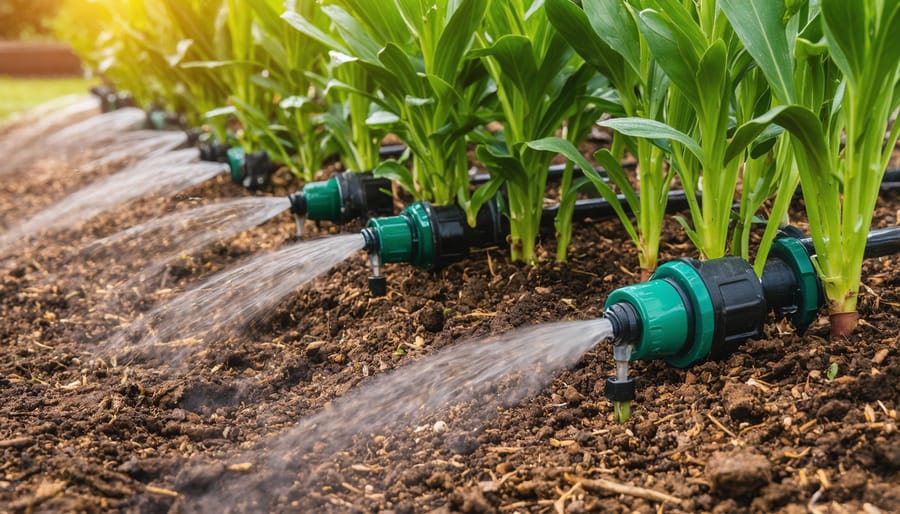
Rainwater Harvesting Basics
Rainwater harvesting is one of the simplest and most rewarding ways to conserve water in your landscape. Instead of letting precious rainfall go to waste, you can capture and store it for future use in your garden. The most basic method is installing rain barrels beneath your downspouts – a weekend project that can save thousands of gallons of water annually.
For those ready to take it a step further, consider creating a rain garden – a shallow depression in your landscape that collects and filters rainwater while supporting beautiful native plants. Position it where downspouts, driveways, or natural slopes direct water flow. Add layers of gravel, sand, and rich soil to help filter the water naturally.
Rain chains offer an attractive alternative to traditional downspouts, guiding water directly into collection vessels or rain gardens while adding visual interest to your home’s exterior. Combine these with permeable pathways and strategic grading to maximize natural water retention in your landscape.
Don’t forget about the role of mulch in rainwater harvesting. A thick layer of organic mulch helps soil retain moisture from rainfall, reducing the need for supplemental watering. Plus, it breaks down over time to enrich your soil.
Remember to check local regulations before installing any rainwater collection system, as some areas have specific guidelines or restrictions in place.
Soil Management for Better Water Retention
Mulching Strategies
Mulching is one of the most effective ways to conserve water in your landscape, acting like a protective blanket for your soil. A 2-3 inch layer of mulch can reduce water evaporation by up to 70% while suppressing water-hungry weeds.
Organic mulches, such as shredded bark, straw, or wood chips, are excellent choices as they gradually break down and improve soil quality. Pine needles work particularly well for acid-loving plants, while cocoa hulls offer an attractive appearance and pleasant scent. For vegetable gardens, straw or grass clippings provide lightweight coverage that’s easy to work with.
When applying mulch, keep it about 2-3 inches away from plant stems and tree trunks to prevent rot. Create a gentle slope in the mulch layer, making it slightly thinner near plants and thicker in the spaces between them. This helps direct water toward plant roots while maintaining proper air circulation.
For areas with strong winds, consider using heavier mulching materials like stone or gravel. These inorganic options provide excellent water retention and won’t blow away, making them perfect for exposed garden beds or xeriscaping projects.
Soil Amendments That Work
Adding organic matter to your soil is like giving your garden a natural water-saving superpower. Compost is your best friend here – it helps improve soil structure and creates tiny pockets that hold water like a sponge. Try mixing in well-aged compost, leaf mold, or aged manure to about 2-3 inches deep.
Wood chips and bark mulch work wonders as top dressing, slowly breaking down to enrich your soil while preventing water evaporation. For clay soils, adding expanded shale or perlite creates better drainage while maintaining moisture. In sandy soils, coconut coir or peat moss can significantly boost water retention.
Here’s a gardener’s secret: worm castings not only add nutrients but also create stable soil aggregates that hold water efficiently. Layer these amendments gradually throughout the growing season, and you’ll notice your plants need less frequent watering. Remember to work them in gently – your soil’s microorganisms will do the rest, creating a water-wise foundation for your landscape.
As we’ve explored throughout this guide, water conservation in landscaping isn’t just about saving water – it’s about creating beautiful, sustainable outdoor spaces that thrive in harmony with our environment. By implementing strategies like proper plant selection, efficient irrigation systems, and smart landscape design, you can reduce your water consumption while maintaining a vibrant garden that brings joy throughout the seasons.
Remember that every small change makes a difference. Whether you start by adding a layer of mulch to your flower beds, installing a drip irrigation system, or replacing thirsty plants with drought-resistant alternatives, you’re contributing to a more sustainable future. The best part is that these changes often lead to lower maintenance requirements and reduced water bills – a win-win situation for both you and the environment.
Consider starting with one or two techniques that feel most manageable for your situation. As you become comfortable with these changes, gradually incorporate more water-saving practices into your landscape routine. The journey to a water-wise garden is ongoing, and it’s perfectly fine to take it one step at a time.
By embracing these water conservation practices, you’re not just creating a more resilient garden – you’re becoming part of a growing community of mindful gardeners who understand that beautiful landscapes and responsible water use can go hand in hand. Let’s make water-wise gardening the new standard in landscape design, one garden at a time.

